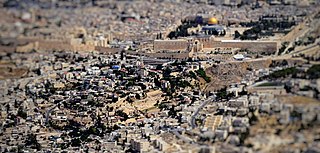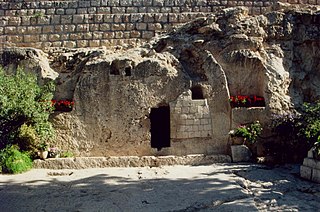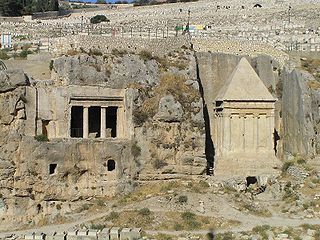 W
WSeveral kinds of archaeological remnants of the Jerusalem Temple exist. Those for what is customarily called Solomon's Temple are indirect and some are challenged. There is extensive physical evidence for the temple called the Second Temple that was built by returning exiles around 516 BCE and stood until its destruction by Rome in the year 70 CE.
 W
WThe Cave of Nicanor is an ancient burial cave located on Mount Scopus in Jerusalem, Israel. Among the ossuaries discovered in the cave is one with an inscription referring to "Nicanor the door maker". The cave is located in the National Botanic Garden of Israel on the grounds of the Mount Scopus campus of the Hebrew University of Jerusalem.
 W
WThe Cave of the Minor Sanhedrin is a burial cave located next to the Tomb of Simeon the Just in the Sheikh Jarrah neighborhood of Jerusalem. It contains 26 burial niches, in which the 26 members of the Minor Sanhedrin are said to be buried. There are also other burial caves in the complex.
 W
WThe Cave of the Ramban is located in the southern cliff of the Upper Kidron Valley, on a slope descending into the Arab neighborhood of Wadi al-Joz, Jerusalem. It is believed by some to be the traditional burial place of Nahmanides, a foremost rabbinical scholar during the medieval era.
 W
WThe Church of the Seat of Mary, Church of the Kathisma or Old Kathisma being the name mostly used in literature, was a 5th-century Byzantine church in the Holy Land, located between Jerusalem and Bethlehem. It was built on the alleged resting place of Mary on the road to Bethlehem mentioned in the Proto-Gospel of James. The church was built when Marian devotion first rose to great importance, following the First Council of Ephesus of 431. It is one of the earliest churches known to have been dedicated to the Theotokos in the entire Byzantine Empire.
 W
WChurch of Zion, Jerusalem, also known as the Church of the Apostles on Mount Zion, refers to the remains of a Roman-era church or synagogue on Mount Zion in Jerusalem that some historians speculate may have belonged to an early Jewish-Christian congregation.
 W
WThe City of David, called in Arabic: وادي حلوه, Wadi Hilweh, a neighborhood of Silwan, is a Palestinian Arab village intertwined with an Israeli settlement, and the archaeological site which is speculated to constitute the original settlement core of Bronze and Iron Age Jerusalem.
 W
WThe Eastern Wall is an ancient structure in Jerusalem that is both part of the eastern side of the city wall of Jerusalem and the eastern wall of the ancient Temple Mount.
 W
WA number of archaeological excavations at the Temple Mount—a celebrated and contentious religious site in the Old City of Jerusalem—have taken place over the last 150 years. Excavations in the area represent one of the more sensitive areas of all archaeological excavations in Jerusalem.
 W
WThe Garden Tomb is a rock-cut tomb in Jerusalem, which was unearthed in 1867 and is considered by some Protestants to be the site of the burial and resurrection of Jesus. The tomb has been dated by Israeli archaeologist Gabriel Barkay to the 8th–7th centuries BC. The re-use of old tombs was not an uncommon practice in ancient times, but this would contradict the biblical text that speaks of a new, not reused, tomb made for himself by Joseph of Arimathea. Also, the trough in front of the tomb and the nearby cistern, described by proponents of the Garden Tomb as part of the tomb's sealing system and as the surrounding garden's source of water, respectively, have both been archaeologically dated to the Crusader period. The organisation maintaining the Garden Tomb refrains from claiming that this is the authentic tomb of Jesus, while pointing out the similarities with the site described in the Bible, and the fact that the Garden Tomb better preserves its ancient outlook than the more traditional, but architecturally altered and time-damaged tomb from the mostly crowded Church of the Holy Sepulchre; for all of these reasons, they suggest that the Garden Tomb is more evocative of the events described in the Gospels.
 W
WGivat HaMivtar is an Israeli settlement and a neighborhood in East Jerusalem established in 1970 between Ramat Eshkol and French Hill. It is located on a hill where an important battle took place in the Six Day War. Archaeological excavations have revealed important ancient Jewish tombs in the region. Givat Hamivtar was one of the first "Build Your Own Home" neighborhoods in Jerusalem.
 W
WThe Givati Parking Lot dig is an archaeological excavation located in the Tyropoeon Valley. It is adjacent to the City of David, the most ancient part of the Canaanite and Israelite city of Jerusalem. The dig is conducted by Doron Ben-Ami and Yana Tchekhanovets of the Israel Antiquities Authority and underwritten by the City of David Foundation.
 W
WThe Huldah Gates were one of the Gates of the Old City of Jerusalem leading into the Jerusalem Temple compound in the Hasmonean period and were named as such in the Mishnah. The term is currently being used for the remains of two later sets of gates, the Triple Gate and the Double Gate, known together as the Huldah Gates, built as part of the much extended Herodian Temple Mount, situated in Jerusalem's Old City. Both sets of gates were set into the Southern Wall of the Temple compound and gave access to the Temple Mount esplanade by means of underground vaulted ramps. Both were walled up in the Middle Ages.
 W
WThe Israelite Tower is an archaeological site in Jerusalem's Jewish Quarter. The site features remains of the city's Iron Age fortifications which were later incorporated into the Hasmonean city walls. It was excavated by Israeli archaeologist Nahman Avigad during the 1970s. Finds unearthed at the site attest to the Babylonian destruction of Jerusalem in 586 BCE.
 W
WJason's Tomb is a rock-cut tomb dating to the first century BCE in the Hasmonean period, discovered in the Rehavia neighborhood in Jerusalem, Israel. It has been identified as the burial site of a certain Jason, possibly a naval commander, based on the charcoal drawing of two warships discovered in the cave.
 W
WThe Jewish Quarter is one of the four traditional quarters of the Old City of Jerusalem. The 116,000 square meter area lies in the southeastern sector of the walled city, and stretches from the Zion Gate in the south, along the Armenian Quarter on the west, up to the Street of the Chain in the north and extends to the Western Wall and the Temple Mount in the east. In the early 20th century, the Jewish population of the quarter reached 19,000.
 W
WThe Monolith of Silwan, also known as the Tomb of Pharaoh's Daughter, is a cuboid rock-cut tomb located in Silwan, Jerusalem dating from the period of the Kingdom of Judah; the latter name refers to a 19th-century hypothesis that the tomb was built by Solomon for his Egyptian wife. The structure, a typical Israelite rock-cut tomb, was previously capped by a pyramid structure like the Tomb of Zechariah. It is one of the more complete and distinctive First Temple-period structures. The pyramidal, rock cap was cut into pieces and removed for quarry, during the Roman era leaving a flat roof. The tomb contains a single stone bench, indicating that it was designed for only one burial. Recent research indicates that the bench was the base of a sarcophagus hewn into the original building.
 W
WNational Botanic Garden of Israel Hebrew: הגן הבוטני לצמחי ארץ ישראל ע"ש מונטג'יו למפורט), not to be confused with Jerusalem Botanical Gardens, which was originally planned as its successor, is a botanical garden located on the Mount Scopus campus of the Hebrew University of Jerusalem. It herbarium and Institution Code is HUJ. It covers an area of 25 dunams and contains 950 varieties of plants, 40% of them wild.
 W
WThe Herodian tower partially preserved in the Citadel of Jerusalem has been identified as either the Phasael Tower or the Hippicus Tower described by Josephus.
 W
WRock-cut tombs are a form of burial and interment chamber used in ancient Israel. Cut into the landscapes surrounding ancient Judean cities, their design ranges from single chambered, with simple square or rectangular layouts, to multi-chambered with more complex designs. Almost all burial chambers contain a platform for primary burial and an ossuary or other receptacle for secondary burial. There is debate on if these tombs were originally intended for secondary burials, or if that practice arose later. The use of rock-cut cave tombs in the region began in the early Canaanite period, from 3100–2900 BCE. The custom lapsed a millennium, however, before reemerging in the earliest Israelite tombs, dating to the 9th century BCE in Jerusalem. The use of rock-cut tombs reached its peak in the 7th and 8th centuries BCE, before rapidly declining and eventually falling out of use in the 6th century BCE in some regions. Use of the tombs has been recorded as recently as the Late Roman Period around the 3rd century CE. The use of such tombs was generally reserved for the middle- and upper-classes, and each typically belonged to a single nuclear or extended family.
 W
WShuafat, also Shu'fat and Sha'fat, is a mostly Arab neighborhood of East Jerusalem, forming part of north-eastern Jerusalem. Located on the old Jerusalem–Ramallah road about three miles north of the Old City, Shu'fat has a population of 35,000 residents.
 W
WSilwan or Siloam is a predominantly Palestinian neighborhood in East Jerusalem, on the outskirts of the Old City of Jerusalem.
 W
WThe Silwan necropolis is the most important cemetery in ancient Judea, and is assumed to have been used by the highest-ranking officials residing in Jerusalem. Its tombs were cut between the 9th and 7th centuries BCE. It is situated on the rocky eastern slope of the Kidron Valley, facing the oldest part of Jerusalem. Part of the Palestinian village of Silwan was later built atop the necropolis.
 W
WThe Southern Wall is a wall at the southern end of the Temple Mount and the former southern side of the Second Temple in Jerusalem. It was built during King Herod's expansion of the Temple Mount platform southward on to the Ophel.
 W
WThe Status Quo is an understanding among religious communities with respect to nine shared religious sites in Jerusalem and Bethlehem. Other Holy Places in Israel and Palestine were not deemed subject to the Status Quo because the authorities of one religion or of one community within a religion are in recognized or effective possession.
 W
WTabachnik National Garden is a National Park located in the southern downs of Mount Scopus in Jerusalem, next to the Hebrew University. The garden preserves some Jewish burial caves from the Second Temple period and two small modern cemeteries, the Jerusalem American Colony Cemetery and the Bentwich Cemetery. Two lookouts are also located within the park, an eastward one facing the Dead Sea and the Judean Desert, and a westward one towards the Temple Mount.
 W
WThe Talpiot Tomb is a rock-cut tomb discovered in 1980 in the East Talpiot neighborhood, five kilometers south of the Old City in East Jerusalem. It contained ten ossuaries, six inscribed with epigraphs, including one interpreted as "Yeshua bar Yehosef", though the inscription is partially illegible, and its translation and interpretation is widely disputed. The tomb also yielded various human remains and several carvings.
 W
WThe Temple Mount Sifting Project is an archaeological project begun in 2004 whose aim is the recovery and study of archaeological artifacts contained within debris which was removed from the Temple Mount in Jerusalem without proper archaeological care.
 W
WTomb of Absalom, also called Absalom's Pillar, is an ancient monumental rock-cut tomb with a conical roof located in the Kidron Valley in Jerusalem, a few metres from the Tomb of Zechariah and the Tomb of Benei Hezir. Although traditionally ascribed to Absalom, the rebellious son of King David of Israel, recent scholarship has dated it to the 1st century CE.
 W
WThe Tomb of Benei Hezir, previously known as the Tomb of Saint James, is the oldest of four monumental rock-cut tombs that stand in the Kidron Valley, adjacent to the Tomb of Zechariah and a few meters from the Tomb of Absalom. It dates to the period of the Second Temple. It is a complex of burial caves. The tomb was originally accessed from a single rock-cut stairwell which descends to the tomb from the north. At a later period an additional entrance was created by quarrying a tunnel from the courtyard of the monument known as "the Tomb of Zechariah". This is also the contemporary entrance to the burial complex.
 W
WThe Tomb of the Prophets Haggai, Zechariah and Malachi is an ancient burial site located on the upper western slope of the Mount of Olives, Jerusalem. According to a medieval Jewish tradition also adopted by Christians, the catacomb is believed to be the burial place of Haggai, Zechariah and Malachi, the last three Hebrew Bible prophets who are believed to have lived during the 6th-5th centuries BC. Archaeologists have dated the three earliest burial chambers to the 1st century BC, thus contradicting the tradition.
 W
WThe Tomb of Zechariah is an ancient stone monument adjacent to the Tomb of Benei Hezir that is considered in Jewish tradition to be the tomb of Zechariah ben Jehoiada. It is a few meters from the Tomb of Absalom and adjacent to the Tomb of Benei Hezir.
 W
WThe Tombs of the Kings are a rock-cut funerary complex in East Jerusalem believed to be the burial site of Queen Helene of Adiabene. The tombs are located 820 meters north of Jerusalem's Old City walls in the Sheikh Jarrah neighborhood
 W
WTombs of the Sanhedrin, also Tombs of the Judges, is an underground complex of 63 rock-cut tombs located in a public park in the northern Jerusalem neighborhood of Sanhedria. Built in the 1st century CE, the tombs are noted for their elaborate design and symmetry. They have been a site for Jewish pilgrimage since the medieval period. The popular name of the complex, which has the most magnificently carved pediment of ancient Jerusalem, is due to the fact that the number of burial niches it contains is somewhat close to that of the members of the ancient Jewish supreme court, the Great Sanhedrin, namely 71.
 W
WThe Tower of David, also known as the Citadel, is an ancient citadel located near the Jaffa Gate entrance to the Old City of Jerusalem.